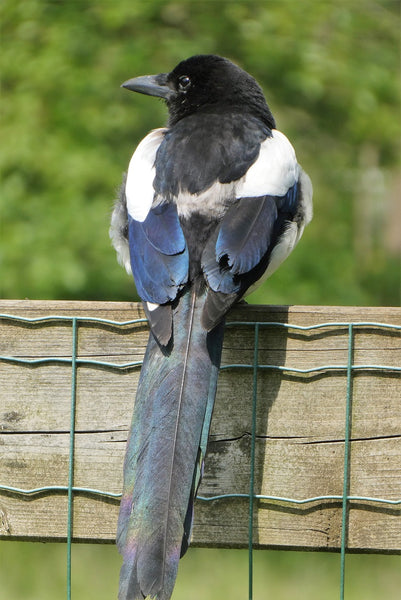When it comes to the decline in songbirds much finger pointing has taken place at Magpies. Find out why these intelligent birds are considered as a pest.
Magpies (Pica pica) are part of the crow family (Corvidae) and are considered to be a very intelligent bird. When seen close-up its black plumage takes on an altogether more colourful hue with a purplish-blue iridescent sheen to the wing feathers, and a green gloss to the tail. The tail is over half the length of the bird and this indicates the status of the bird in society.
Juveniles appear from May onwards and look similar to adults; the only real difference is in the length of the tail, which is much shorter, about half the length of an adult.
Magpies are often considered as pests, jacks of all trades – scavengers and predators, but actually they can be quite interesting birds and this can usually be overlooked as can their intelligence and arguably their beauty.
The Magpie has always been surrounded by superstition and a rather dramatic poem that has many versions and commonly begins: One for sorrow, two for joy….
The call of a Magpie is very vocal it is a chattering noise “chacker chacker” and the sound is unmistakable. They usually parade around in small groups which is commonly referred to collectively as a troop of Magpies and the most descriptive name for a large group of Magpies is called ‘’a parliament”.
They reside throughout the UK, in Towns & Cities gardens, parks, woodlands, farmland and hedgerows. They will forage for food which includes insects, carrion, scraps, seed mixes, fruit and fat balls and their favourite: road kill. They are not fussy eaters and will have a go at all most anything! They will raid nests for eggs and this is one of the main reasons people dislike Magpies.
The perfect food for Magpies is Prosecto Insectivorous™ as it's a year round soft food which is made to a special crumbly/moist formula. It contains a variety of ingredients blended with special oils and Bakers' Honey plus vitamins and minerals. Made to retain its freshness, it will not turn sour. Magpies and insect-eating birds love this protein-rich mixture.
Feed from a softfood feeder or a sheltered bird table, it is also suitable for feeding in a small container at the base of shrubs or bushes. It's good, it's wholesome, it's nutritious and it’s perfect for the Magpies.

Written by Tina Jakes


